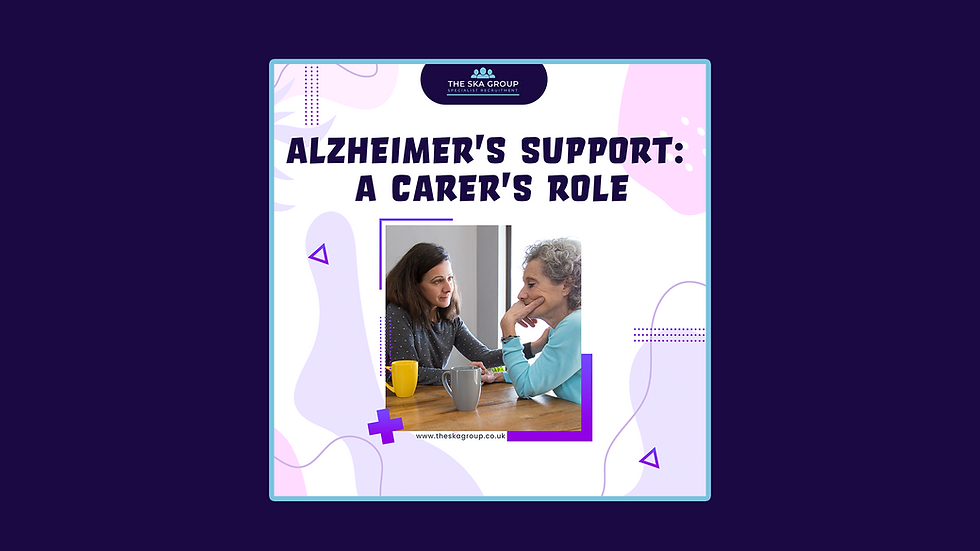Inclusive Care: Supporting LGBTQ+ Clients with Respect and Compassion
- Emily

- Jun 6
- 3 min read
Providing high-quality care goes beyond meeting physical needs; it requires understanding, empathy, and respect for each individual's identity. For LGBTQ+ clients, inclusive care can have a profound impact on their health, wellbeing, and trust in care services. As care and support professionals, it's vital to create an environment where all individuals feel safe, valued, and seen for who they truly are.
This article explores how care workers and organisations can support LGBTQ+ clients with respect and compassion, while building a culture of inclusivity in the care sector.
Understanding LGBTQ+ Identities
LGBTQ+ stands for Lesbian, Gay, Bisexual, Transgender, Queer/Questioning, and others under the broader umbrella of gender and sexual diversity. It includes people who may identify as non-binary, intersex, asexual, pansexual, and more.
It is important to remember:
Every LGBTQ+ individual has a unique story.
Gender identity is different from sexual orientation.
Respect begins with listening and never making assumptions. For example, never assume someone’s pronouns, partner(s), or history. When in doubt, ask respectfully or wait until the client shares.
The Importance of Inclusive Care
Research shows that LGBTQ+ people are more likely to face health disparities and barriers to accessing services due to past discrimination or fear of mistreatment. For older LGBTQ+ adults, some may have lived through decades of prejudice and feel hesitant to disclose personal details.
Inclusive care means:
Providing safe, non-judgmental environments.
Respecting identities, pronouns, and relationships.
Ensuring staff are trained and informed.
Compassionate care that affirms identity fosters trust, encourages engagement, and improves outcomes.
Practical Ways to Support LGBTQ+ Clients
1. Use Inclusive Language
Avoid gendered terms unless preferred by the client (e.g., use "partner" instead of "husband/wife").
Ask for and respect pronouns.
Mirror the language a client uses about themselves.
2. Create a Welcoming Environment
Display inclusive symbols (e.g., rainbow flags, pronoun badges).
Use intake forms that allow for diverse gender identities and relationship structures.
Provide private spaces for conversations about gender or orientation.
3. Training and Awareness
Regular staff training on LGBTQ+ issues should be mandatory.
Training should include terminology, real-world scenarios, and how to challenge bias.
Encourage open discussions and reflection.
4. Protect Privacy and Confidentiality
Never disclose someone’s identity without consent.
Respect a client’s choice to be open in some settings but private in others.
5. Be an Ally
Speak up if you witness discrimination.
Support clients who may be navigating identity-related challenges.
Treat LGBTQ+ clients with the same dignity and care as anyone else, without exception.
Supporting LGBTQ+ Clients in Later Life
LGBTQ+ people in older age groups may have unique concerns, especially if they lack family support or have experienced trauma or exclusion. Some may be re-closeted in care settings, fearing rejection or misunderstanding.
Care workers should:
Acknowledge and affirm life histories and partnerships.
Avoid making assumptions about family structures.
Encourage open dialogue while respecting boundaries.
Showing genuine interest in a client’s experiences helps them feel valued and respected.
Building Organisational Culture of Inclusion
Inclusive care isn't only the responsibility of individual care workers — it's a team effort supported by leadership, policies, and culture.
Organisations can:
Develop and enforce inclusive policies.
Celebrate LGBTQ+ awareness days (e.g., Pride Month, Trans Day of Visibility).
Recruit a diverse workforce and support LGBTQ+ staff.
Feedback from clients and staff should be welcomed and used to improve inclusivity.
Common Mistakes to Avoid
Misgendering or using incorrect names: Apologise and correct yourself without making a big deal.
Assuming heterosexuality: Not all clients have opposite-sex partners or traditional family setups.
Tokenism: Inclusion isn't just symbolic; it must be meaningful and consistent.
Over-questioning: Curiosity is natural, but clients are not obligated to educate others.
Final Thoughts
Inclusive care is compassionate care. It begins with recognising the dignity of every person and creating environments where all clients can thrive.
By learning, listening, and leading with respect, care workers can make a genuine difference in the lives of LGBTQ+ individuals.
For The SKA Group, championing inclusion isn't just good practice — it's part of delivering the high-quality, person-centred care that everyone deserves.
Together, we can build a future where care is safe, inclusive, and respectful for all.




Comments